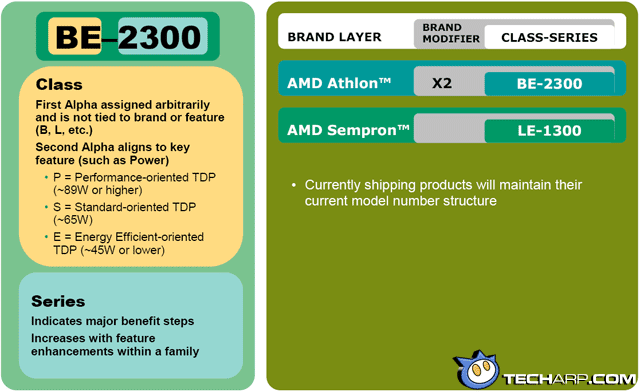New Processor Number Scheme
With the advent of their Core 2 microarchitecture, Intel realized that they could no longer market these new processors based on their operating frequencies (in MHz / GHz). That's when they stepped away from processor clock speeds and started giving their processors model numbers based on their performance.
AMD stopped basing their model numbers on clock speeds long ago, but they did something almost as bad - they based their model numbers on the clock speed of a roughly equivalent Intel processor! For example, the Athlon 64 X2 5200+, which only ran at 2.6 GHz, was labelled as such to give the perception that this processor is capable of outperforming an equivalent Pentium 4 processor running at 5.2 GHz.
Now that Intel moved away completely from clock speeds, AMD can no longer use their Performance Plus (P+) rating. Hence, they developed a new naming system, outlined below.

In this new naming system, the first letter in the model number will be assigned arbitratily by AMD. For example, B for the AMD Athlon X2 and L for the AMD Sempron. Although AMD says they don't mean a thing, B could be short for Business while L could mean Low-End.
The second letter in the model number denotes the thermal output (and power consumption) of the processor. This is followed by a four-number series which indicate the performance level of the processor. This system allows the user to quickly determine the features and performance level of the processor at a glance.
Phenom Processor Details
AMD has not been forthcoming about the actual processor details. They cannot even tell us how the Phenom processors will differ from the Quad-Core Opteron (Barcelona) processors. However, we should probably expect the Phenom processors to have smaller caches and lower clock speeds. With the Quad-Core Opteron delivering a clock speed of only 2 GHz at launch, it's unlikely that the first Phenom processors will exceed that.
On the other hand, it has been reported (albeit unofficially) that AMD will be releasing the following Agena and Kuma models :
Processor |
Cores |
Model |
Clock Speed |
HyperTransport |
Socket |
L2 & L3 Cache |
Phenom FX |
4 |
FX-91 |
2.8 GHz |
2.1 GHz |
F |
512 KB L2 cache x 4 cores 2 MB L3 cache shared |
FX-90 |
2.6 GHz |
1.9 GHz |
||||
FX-80 |
2.6 GHz |
AM2+ |
||||
Phenom X4 |
4 |
GP-7100 |
2.4 GHz |
1.8 GHz |
||
GP-7000 |
2.2 GHz |
1.6 GHz |
||||
Phenom X2 |
2 |
GP-6800 |
2.8 GHz |
2.1 GHz |
512 KB L2 cache x 2 cores 2 MB L3 cache shared |
|
GS-6650 |
2.6 GHz |
1.9 GHz |
||||
GS-6550 |
2.4 GHz |
1.8 GHz |
||||
GE-6600 |
2.3 GHz |
1.7 GHz |
||||
GE-6500 |
2.1 GHz |
1.5 GHz |
||||
GE-6400 |
1.9 GHz |
1.4 GHz |
AMD has said that they will release the first Phenom processors before the end of 2007, but considering numerous delays plaguing the Quad-Core Opteron processor, it's likely we will not see the Phenoms released until early 2008. This is especially likely since ODMs have been reported complaining about lack of 2.0 GHz Quad-Core Opteron parts.
Socket Compatibility
All Phenom processors, with the exception of some high-end Phenom FX processors, will support current Socket AM2 motherboards, as well as the newer Socket AM2+.
According to AMD, the only difference between Socket AM2 and Socket AM2+ is the support for HyperTransport 3.0 which allows for a higher transfer rate of 20.8 GB/s at 2.6 GHz.
Current Socket AM2 users will have no problem replacing their Athlon (64) X2 processors with the new Phenom processors. They will just need a BIOS update to recognize the new processors.
The top Phenom FX models is said to support only Socket F. This is kind of odd since that would position them in the workstation/server market rather than the desktop market which it's meant for.
Lower Power Consumption
Like the Quad-Core Opteron (Barcelona) processors, all Phenom processors will be fabricated on the 65 nm process technology on SOI (Silicon On Insulator) substrates. This allows AMD to deliver thermal design power (TDP) levels at or below 65 W. This is about 24 W (27%) lower than that of current Athlon 64 X2 processors which are based on the 90 nm process technology.
This is part of AMD's strategy to meet the low-power, low-noise requirements of their AMD Live! home entertainment initiative. But even if you intend to use these processors in a high-end gaming PC, lower thermal output is always a good thing.
<<< AMD Phenom Processor (Agena & Kuma) Pre-Launch Update, The New Phenom Family : Previous Page | Next Page : Conclusion >>>







 Add to Reddit
Add to Reddit
